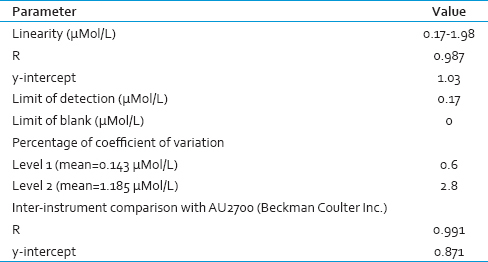Translate this page into:
Establishing Syva Methotrexate Assay on Siemens Dimension RxL Analyzer: Experience in a Tertiary Cancer Care Laboratory
Address for correspondence: Dr. Preeti Chavan, E-mail: pchavan@actrec.gov.in
This is an open access article distributed under the terms of the Creative Commons Attribution-NonCommercial-ShareAlike 3.0 License, which allows others to remix, tweak, and build upon the work non-commercially, as long as the author is credited and the new creations are licensed under the identical terms.
This article was originally published by Medknow Publications & Media Pvt Ltd and was migrated to Scientific Scholar after the change of Publisher.
Sir,
Methotrexate (MTX) is an antifolate drug, which is used in the treatment of neoplastic as well as some nonneoplastic diseases in varying doses. In high doses, it is used to treat malignant diseases such as systemic non-Hodgkin's lymphoma, osteosarcoma, central nervous system metastases, and acute lymphoblastic leukemia. While in low doses, it is used in the treatment of nonneoplastic diseases such as psoriasis and rheumatoid arthritis.[1] It acts by the mechanism of interfering with folate metabolism by inhibiting enzymes such as dihydrofolate reductase. Reduced folate is required for DNA synthesis by the cells. The multiplying malignant cells which require greater amount of this reduced folate are affected leading to cessation of DNA synthesis and eventual cell death. However, normal cell metabolism too gets affected due to the reduced folate levels. To counter this, supplementation of leucovorin which is a formulation of reduced folate is given to patients. This is also known as leucovorin rescue.[2] MTX toxicity is monitored using measurement of drug levels in the blood at timed intervals. The analytical range for the Syva EMIT MTX assay is 0.3–2 μMol/L; however, in clinical practice, the levels of MTX are frequently maintained below this limit for leucovorin rescue and need to be measured. This study was undertaken to establish the Syva EMIT MTX assay on Siemens Dimension RxL analyzer and to evaluate its linearity below 0.3 μMol/L.
Syva EMIT MTX assay uses homogenous enzyme immunoassay technique. It is based on the principle of competitive binding between the drug in the assay and drug labeled with the enzyme glucose-6-phosphate dehydrogenase for the antibody binding site. Serum or plasma is used for testing. Samples collected in heparin, ethylenediaminetetraacetic acid, and oxalate anticoagulants are acceptable. Sample volume required is dependent on the instrument used. The kit includes reconstitution of antibody/substrate reagent A and enzyme reagent B. It also contains buffer concentrate and calibrators. Reconstituted reagents A and B are kept overnight at 2–8°C. Calibrator and buffer are reconstituted the next day. The working reagents A and B are prepared and filled in the cartridges. The reagents are now loaded on the analyzer and the parameter is calibrated. The Syva EMIT MTX assay on Siemens Dimension RxL is a 5-point logit calibration assay. The calibrator values range from 0.2 to 2.0 μMol/L.
Following calibration, all the quality parameters such as precision, linearity, limit of detection, limit of blank, and EQAS-Trend analysis were assessed as per the standard laboratory protocol. For precision, five samples were processed five times and percentage of coefficient of variation (CV%) of the readings was determined. For linearity, calibrator of value 2.0 μMol/L was diluted serially with buffer and values of successive dilutions were measured. Values obtained were plotted against expected values and regression analysis was done. Samples known to not contain MTX drug were processed for limit of blank. Inter-instrument comparison analysis was carried out on 11 samples which were processed for MTX levels on Olympus AU 2700 fully automated biochemistry analyser (Beckman Coulter Inc, Brea, California, USA) with the Syva Emit Assay kit. Bio-Rad controls, level 1 with a mean value of 0.431 μMol/L and level 2 with a mean value of 1.185 μMol/L, were used for internal quality controls (IQCs). Mean, standard deviation, and CV% were calculated. The linearity was 0.17–1.98 μMol/L, the R2= 0.987, and y-intercept of 1.03 was observed. The limit of detection was 0.17 μMol/L and limit of blank was 0 μMol/L. The inter-instrument comparison analysis by linear regression showed R2= 0.991 and y-intercept of 0.871. The IQC showed CV% of 0.6% for level 1 and 2.8% for level 2 [Table 1].

The linearity obtained in our study was higher compared to that obtained by Borgman et al.[3] on Siemens Viva-E instrument. However, it was much lower compared to the lower limit of 0.3 μMol/L claimed by the kit manufacturer. This corroborates with findings by Wilson et al.,[4] who reported lower sensitivity for MTX levels below 0.2 μMol/L with this assay. The CV% for both levels of controls was comparable in our study to that claimed on Siemens Viva-E instrument at <4%. The imprecision range in our study was much lower at 0.6–2.8% compared to another study by Suh-Lailam et al.,[5] which showed an imprecision range of 5.31–8.43%. In conclusion, although the Siemens Syva EMIT MTX assay claims an analytical range of 0.3–2.0 μMol/L, values up to 0.17 μMol/L can be reported on Siemens Dimension RxL analyzer.
Financial support and sponsorship
Nil.
Conflicts of interest
There are no conflicts of interest.
REFERENCES
- Determination of methotrexate in serum by a rapid, fully mechanized enzyme immunoassay (EMIT) J Clin Chem Clin Biochem. 1980;18:169-74.
- [Google Scholar]
- Harrison's Principles of Internal Medicine (17th ed). USA: The McGraw-Hill Companies, Inc.; 2008. Ch. 81
- Improved sensitivity for methotrexate analysis using enzyme multiplied immunoassay technique on the Siemens Viva-E instrument. Ther Drug Monit. 2012;34:193-7.
- [Google Scholar]
- External quality assessment of Syva Emit and Abbott TDx II assays for methotrexate in serum. Ther Drug Monit. 1996;18:721-3.
- [Google Scholar]
- Performance Characteristics of Three Assays for the Therapeutic Drug Monitoring of Methotrexate. In: Abstract Presentation, Thirteenth International Congress of Therapeutic Drug Monitoring and Clinical Toxicology, USA. September, 2013.
- [Google Scholar]




